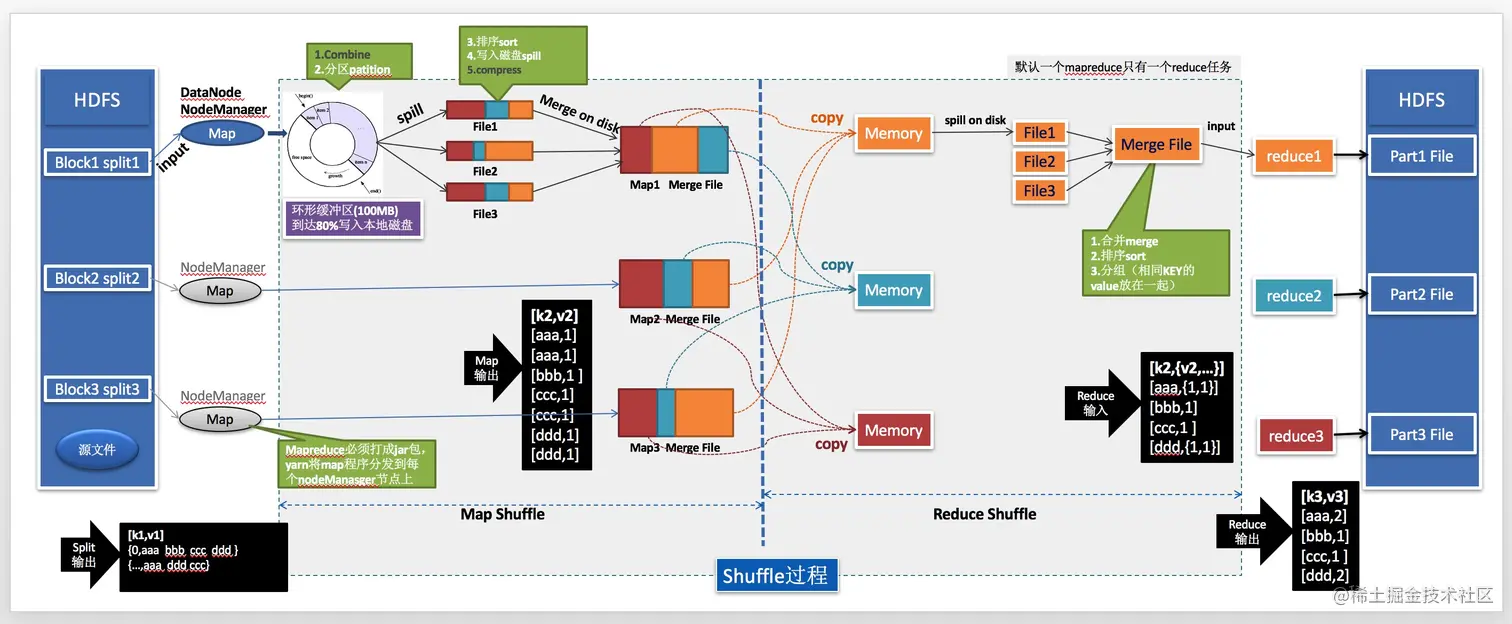
MapReduce的原理
MapReduce由两个主要阶段组成:Map和Reduce。在Map阶段中,数据集被分成若干个小块,每个小块由Map函数处理,输出一系列键值对。在Reduce阶段中,键值对被聚合成一组较小的结果集。下面我们详细讲解每个阶段的原理。
Map阶段
Map阶段的输入是原始数据集。它将输入数据划分成若干个小块,每个小块由Map函数处理。Map函数的输入是键值对,输出也是键值对。在Map函数中,对每个输入键值对进行操作,生成一组中间键值对,这些中间键值对将作为Reduce阶段的输入。
Reduce阶段
Reduce阶段的输入是Map阶段输出的中间键值对集合。Reduce函数对每个键执行聚合操作,并将结果输出到最终结果集。Reduce函数的输出通常是单个键值对,但也可以是多个键值对。
Shuffle阶段
Shuffle阶段在Map和Reduce阶段之间执行。在Map阶段中,每个Map任务都会生成一组中间键值对。在Shuffle阶段中,这些中间键值对将按照键进行排序并分组,以便Reduce任务可以并行处理具有相同键的中间结果。
MapReduce程序实现
下面我们将使用Java编写一个简单的MapReduce程序。这个程序将计算输入文本中每个单词的出现次数。
首先,我们需要编写Map函数。Map函数将输入文本中的每个单词映射为一个键值对,其中键是单词本身,值是1。以下是Map函数的代码:
public static class Map extends Mapper<LongWritable, Text, Text, IntWritable> {
private final static IntWritable one = new IntWritable(1);
private Text word = new Text();
public void map(LongWritable key, Text value, Context context) throws IOException, InterruptedException {
String line = value.toString();
StringTokenizer tokenizer = new StringTokenizer(line);
while (tokenizer.hasMoreTokens()) {
word.set(tokenizer.nextToken());
context.write(word, one);
}
}
}
接下来,我们编写Reduce函数。Reduce函数将具有相同键的值相加,并将结果作为键值对输出。以下是Reduce函数的代码:
javaCopy codepublic static class Reduce extends Reducer<Text, IntWritable, Text, IntWritable> {
public void reduce(Text key, Iterable<IntWritable> values, Context context) throws IOException, InterruptedException {
int sum = 0;
for (IntWritable value : values) {
sum += value.get();
}
context.write(key, new IntWritable(sum));最后,我们将Map函数和Reduce函数组合起来,并将它们作为MapReduce程序的一部分提交给Hadoop集群。以下是完整的MapReduce程序:
import java.io.IOException;
import java.util.StringTokenizer;
import org.apache.hadoop.conf.Configuration;
import org.apache.hadoop.fs.Path;
import org.apache.hadoop.io.IntWritable;
import org.apache.hadoop.io.LongWritable;
import org.apache.hadoop.io.Text;
import org.apache.hadoop.mapreduce.Job;
import org.apache.hadoop.mapreduce.Mapper;
import org.apache.hadoop.mapreduce.Reducer;
import org.apache.hadoop.mapreduce.lib.input.FileInputFormat;
import org.apache.hadoop.mapreduce.lib.output.FileOutputFormat;
public class WordCount {
public static class Map extends Mapper<LongWritable, Text, Text, IntWritable> {
private final static IntWritable one = new IntWritable(1);
private Text word = new Text();
public void map(LongWritable key, Text value, Context context) throws IOException, InterruptedException {
String line = value.toString();
StringTokenizer tokenizer = new StringTokenizer(line);
while (tokenizer.hasMoreTokens()) {
word.set(tokenizer.nextToken());
context.write(word, one);
}
}
}
public static class Reduce extends Reducer<Text, IntWritable, Text, IntWritable> {
public void reduce(Text key, Iterable<IntWritable> values, Context context) throws IOException, InterruptedException {
int sum = 0;
for (IntWritable value : values) {
sum += value.get();
}
context.write(key, new IntWritable(sum));
}
}
public static void main(String[] args) throws Exception {
Configuration conf = new Configuration();
Job job = Job.getInstance(conf, "wordcount");
job.setJarByClass(WordCount.class);
job.setMapperClass(Map.class);
job.setCombinerClass(Reduce.class);
job.setReducerClass(Reduce.class);
job.setOutputKeyClass(Text.class);
job.setOutputValueClass(IntWritable.class);
FileInputFormat.addInputPath(job, new Path(args[0]));
FileOutputFormat.setOutputPath(job, new Path(args[1]));
System.exit(job.waitForCompletion(true) ? 0 : 1);
}
}
在上面的代码中,我们首先定义了Map类和Reduce类,然后在main函数中将它们组合起来,使用Job类将程序提交给Hadoop集群进行处理。我们使用FileInputFormat和FileOutputFormat指定输入和输出路径。
总结
本文介绍了MapReduce的原理和使用Java编写MapReduce程序的方法。MapReduce是一个强大的并行编程模型,可用于处理大规模数据集。如果你正在处理大数据集,那么MapReduce可能是你的首选方案。